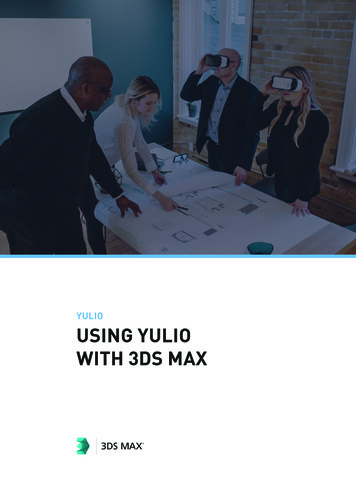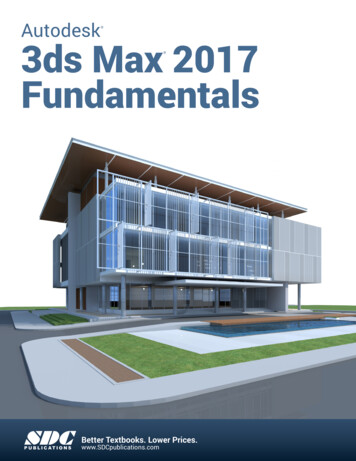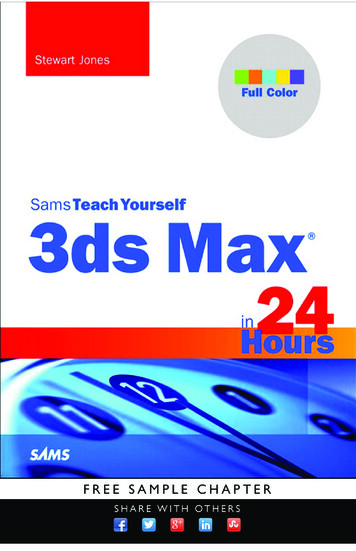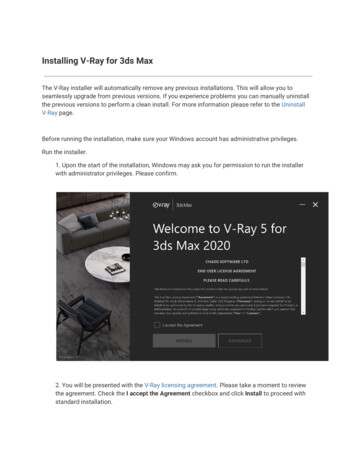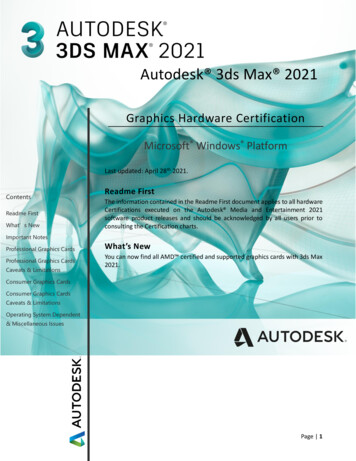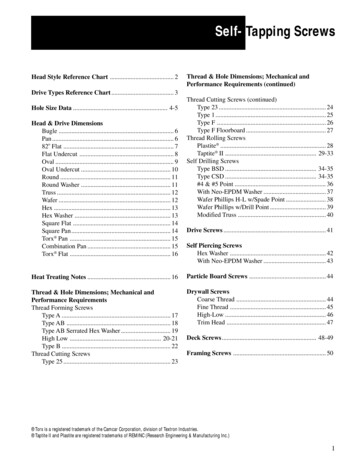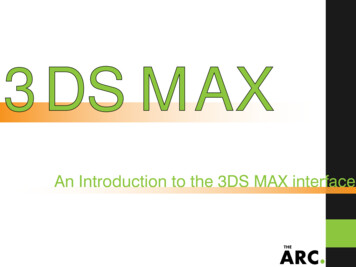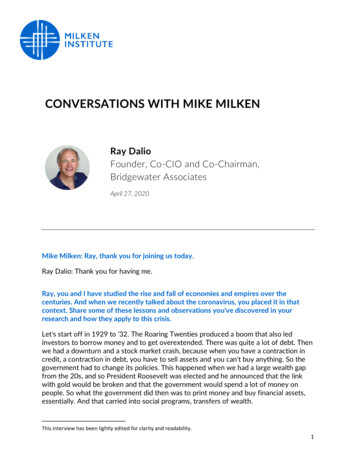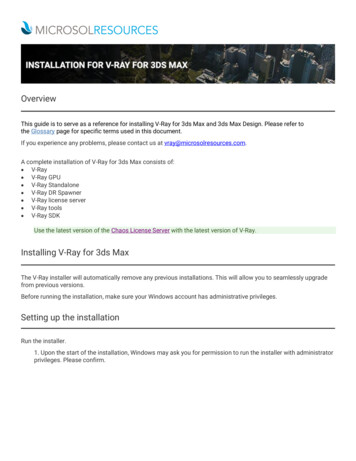
Transcription
OverviewThis guide is to serve as a reference for installing V-Ray for 3ds Max and 3ds Max Design. Please refer tothe Glossary page for specific terms used in this document.If you experience any problems, please contact us at vray@microsolresources.com.A complete installation of V-Ray for 3ds Max consists of: V-Ray V-Ray GPU V-Ray Standalone V-Ray DR Spawner V-Ray license server V-Ray tools V-Ray SDKUse the latest version of the Chaos License Server with the latest version of V-Ray.Installing V-Ray for 3ds MaxThe V-Ray installer will automatically remove any previous installations. This will allow you to seamlessly upgradefrom previous versions.Before running the installation, make sure your Windows account has administrative privileges.Setting up the installationRun the installer.1. Upon the start of the installation, Windows may ask you for permission to run the installer with administratorprivileges. Please confirm.
2. You will be presented with the V-Ray licensing agreement. Please take a moment to review the agreement.Check the I accept checkbox and click Next to proceed.3. During the next step you can choose the installation type. The available installation types are:Workstation – This is a full installation and includes all components as described in the “Installationoverview” section. It will allow you to use V-Ray in 3ds Max, do Distributed or Network Rendering, run VRay GPU render server, use V-Ray SDK, and have V-Ray license server on this machine.3ds Max render slave – This installation includes V-Ray, V-Ray GPU, V-Ray Standalone, V-Ray DR Spawner,and external V-Ray tools. This option does not include the local V-Ray license server application. Pleasechoose this option if you plan to use this machine for Distributed or Network Rendering with V-Ray.Standalone render slave – This installation includes V-Ray Standalone and V-Ray GPU render server.Please choose this option if you plan to use this machine only for Distributed Rendering with V-RayStandalone and a V-Ray GPU render server.The V-Ray Standalone version included in the 3ds Max installer is intended for DR use when V-Ray GPU is set. Itis not a replacement for the 3ds Max render slave, which is intended for use with the V-Ray renderer.
4. After you choose the installation type you click the “Customize” button & adjust the correspondinginstallation settings. If you selected the Workstation installation, you’ll see a full list of customizable settings:Uninstall previous installations – Leave this checked to automatically uninstall any previous versions.Register V-Ray menus – Leave this checked to integrate V-Ray menus within the 3ds Max interface.Help us improve V-Ray – Participate in the improvement decisions for future version of V-Ray. No intelligenceproperty is violated when agreeing to participate in the feedback program. We do not gather scenes, assets,materials, etc. What we receive is user preferences on just a few key render settings and the resulting rendertimes. The point of this feature is to improve V-Ray's performance and the user experience. This preference canbe changed at any time later on from the V-Ray Setup V-Ray About V-Ray Feedback program settings.How are you going to connect to the V-Ray license server? – Specifies whether the V-Ray license server willrun locally or on another machine.If you select the option Remote V-Ray license server on the network, you will have to fill in the IP addressof your V-Ray license server in the field Primary License Server. Please leave the port 30304 unchanged.Specify installation paths – Please check if the default folders are correct.
Common settings for Workstation installation for 3ds Max 2018 with a remote license server and default paths,should look like the screenshot below:5. When ready click the “Install Now” button.6. If the installer detects any applications that need to be closed, they will be listed before being able tocontinue. Please close them and click "Install Now".List of running applications to closeInstallation can continue with applicationsclosed
Completing the installationPlease skip the steps that are not relevant for your installation type.1. After you click the “Install Now” button, the installer will proceed to uninstall any previous versions and installV-Ray Next on your machine.Uninstalling old versionsInstallation new version2. If the installation was successful, you will get this screen. Press the “Finish” button.
3. After you press Finish, the Online License Server installation window will appear next. The Online License Server will skip its installation process for two reasons:If it detects a previous installation of the Online License Server on your machine.If you choose the option Remote V-Ray license server on the network.To make sure that your license server is up and running and you have the necessary licenses, please proceed tothe Set Up Your V-Ray License page.
GlossaryGeneral TermsAnalytic samplingThis is one of the V-Ray's techniques for calculating motion blur. Instead of taking a number of time samples, theanalytic method blurs the moving triangles perfectly. It will take in consideration all triangles crossing a given rayduring a given time interval. Keep in mind that because of its precision this method will be extremely slow on highpoly scenes with fast motion. (See also: Motion blur, Quasi Monte Carlo sampling)Anti-aliasing (Image Sampling)Anti-aliasing is a special technique for producing smooth images of high-contrast edges and small details inmaterials and objects. V-Ray achieves anti-aliasing by taking additional image samples where necessary. Todetermine if more samples are needed, V-Ray compares differences in color (and/or other properties) ofneighboring image samples. This comparison can be performed in several ways. V-Ray supports fixed, simple 2level, and adaptive anti-aliasing. Anti-aliasing settings can be found under V-Ray's Image Sampler settings. (Seealso: G-Buffer Anti-aliasing)Area lights (Rectangle light)An area light is a non-point light source. These types of light sources produce area shadows. V-Ray supportsrendering of area lights through VRayLight. (See also: Area shadows)Area shadows (Soft shadows)Area shadows are blurred shadows (or shadows with blurred edges) that are caused by non-point light sources(Area lights). V-Ray is capable of producing the effect of area shadows either through VRayShadow or through arealights. (See also: Area lights)BRDF (Bi-Directional Reflectance Distribution Function)One of the most general means to characterize the reflection properties of a surface is by use of the bi-directionalreflection distribution function (BRDF), a function which defines the spectral and spatial reflection characteristic of asurface. V-Ray supports the following BRDF types: Phong, Blinn, and Ward. BRDF settings can be found with the VRay material VRayMtl.BSP (BSP Tree, Binary Space Partitioning Tree)BSP is special data structure for organizing scene geometry in order to speed up ray-triangle intersections(intersecting a ray with the triangles in the scene is the task most frequently performed by a raytracer). Currently V-
Ray implements two types of BSP Tree. These are a static BSP Tree for scenes without motion blur and a motionblur BSP Tree. V-Ray also uses the Intel Embree raycaster to accelerate raycasting. (See also: Motion Blur)Bucket (Region, Rendering region)A bucket is a rectangular part of the current frame that is rendered independently from other buckets. The divisionof a frame into rendering regions allows for optimal resource utilization (CPUs, PCs, memory). It also allows fordistributed rendering. (See also: Distributed Rendering)Caustics (Radiosity)This is the effect of light refracted by a non-opaque object hitting a (diffuse) surface.Depth of field (DOF)Depth of field is the effect of having a particular point in the scene to appear focused (sharp) and the rest to out offocus (blurry) depending on camera shutter properties and the distance from the camera. This is similar to how realworld cameras work so this effect is especially useful for producing photorealistic images. Depth of field settingsare usually found under the V-Ray Camera.Distributed rendering (DR)Distributed rendering is a technique for utilization of all available computational resources (all CPUs in a machine,all machines in a LAN, etc.). DR divides the currently processed frame into rendering regions and keeps all CPUs inLAN-connected machines busy computing the rendering result. Overall DR assures that V-Ray makes the most outof your equipment when rendering a single frame.3ds Max: For animation sequences, the standard network rendering should be used as it may be more efficient.Early terminationEarly termination is a technique for reducing the samples taken for evaluating a blurry value. This basically works bylooking at the samples as they are computed one by one and deciding, after each new sample, if more samples arerequired. Early termination is used throughout V-Ray for all blurry values. (See also: Importance sampling)G-BufferThis term describes the collection of various data generated during image rendering. These could be Z-values,material IDs, object IDs, non-clamped colors, etc. This has proven to be very useful for performing post-renderingimage processing. (See also: G-Buffer Anti-aliasing, Image Sampler)G-Buffer Anti-aliasingV-Ray is capable of anti-aliasing the rendered image based on the differences in one or several G-Buffer channels.(See also: Anti-aliasing)
HDRI (High Dynamic Range Image)A High Dynamic Range Image is an image containing a high-dynamic range of colors (with components exceedingthe range 0.0-1.0, or 0-255). This type of images is often used as an environment map to light the scene with naturallight.Importance samplingImportance sampling is a technique for basing the number of samples required for evaluating a blurry value, on theeffect that value has on the final result. For example, dark materials require fewer samples for evaluating GI thanbright materials; dim area lights can do with less samples than bright lights etc. Importance sampling is usedthroughout V-Ray for all blurry values. (See also: Early termination)Index of Refraction (IOR)The index of refraction is defined as the speed of light in vacuum divided by the speed of light in a given medium.IOR C/V, where V is the light speed specific for the different mediums.3ds Max: To achieve a material with a specific IOR, you have to set the Index of refraction field value in Max'sstandard materials in the section Extended parameters.MaterialIndexVacuum1.00000Air at STP1.00029Ice1.31Water at 20 C1.33Acetone1.36Ethyl alcohol1.36Sugar solution(30%)1.38Fluorite1.433Fused quartz1.46Glycerin1.473Sugar solution (80%)1.49Typical crown glass1.52Crown glasses1.52-1.62Spectacle crown, C-11.523
Sodium chloride1.54Polystyrene1.55-1.59Carbon disulfide1.63Flint glasses1.57-1.75Heavy flint glass1.65Extra dense flint, EDF-31.7200Methylene iodide1.74Sapphire1.77Heaviest flint glass1.89Diamond2.417Indirect Illumination (Global lighting, Global Illumination, GI)In the real world, when a particle ray of light hits an object, it produces multiple reflected rays with different intensityin all directions. These rays on their turn may hit some other objects and produce even more rays and so on. Thisprocess, multiply repeated, generates the so-called Global Illumination. (See also: Irradiance Map)Irradiance mapIndirect Illumination in V-Ray is generally achieved by calculating GI samples. The irradiance map is a special cachewhere V-Ray keeps precalculated GI samples. During the rendering process when V-Ray needs a particular GIsample, it computes it by interpolating the nearest precalculated GI samples stored in the irradiance map. Oncecomputed, the Irradiance map can be saved in a file and reused in subsequent renderings. This can be especiallyuseful for camera fly-through animations. Samples for VRayLight can also be stored in the irradiance map. (Seealso: Indirect Illumination, Area lights , Area shadows)Low accuracy computationsIn certain cases, V-Ray will not need to compute a ray contribution to the final image with absolute precision. V-Raywill then use faster but less precise methods for computation and will take fewer samples. This produces slightlynoisier results, but decreases rendering times.(Quasi) Monte Carlo samplingMonte Carlo sampling is a method for numerical computation of integrals of functions by evaluating these functionsat a number of random points. Quasi Monte Carlo sampling is a modification of this method, which instead of
randomly generated points, it uses points forming a low-discrepancy sequence, which are more evenly distributedthan purely random ones. This is the method used by V-Ray to evaluate complex effects such as global illumination,blurry reflections, depth of field, motion blur and image anti-aliasing.Motion BlurThis effect is observed when looking at a fast-moving object. The motion is so fast that one cannot focus the object,and the object's image appears blurred to the viewer. Motion Blur parameters can usually be found under the V-RayCamera settings. (See also: Analytic sampling, Monte Carlo sampling)Photon, Photon mapThis is a simulation of a real world photons (light particles). In order to produce caustics effects, V-Ray tracescertain amount of photons that come out of the light sources. Then the results are stored in a photon map and usedduring the rendering process so that highly realistic caustic effects are produced.ReflectionsAs an advanced raytracer, V-Ray supports accurate reflections. Glossy reflections are as well supported.RefractionsRefraction is the bending of a wave when it enters a medium where its speed is different. The refraction of lightwhen it passes from a fast medium to a slow medium bends the light ray toward the normal to the boundarybetween the two media. As an advanced raytracer, V-Ray supports true accurate refractions. V-Ray also handlesglossy refractions.Russian rouletteThis is a technique for reducing variance (i.e. noise) by eliminating computationally intensive paths with little or nocontribution to the final picture, without introducing bias.SubdivsIn V-Ray, subdivs is a measure for the maximum amount of samples (rays) that V-Ray will use to compute a certainvalue. The maximum number of samples is proportional to the square of the subdivs value. For example, if thesubdivs value of a glossy reflection is 5, V-Ray will never make more than 5 x 5 25 samples to evaluate thereflection.TranslucencyTranslucency is a term describing the interaction of light with a non-opaque medium (wax, marble, skin, etc.). V-Raysupports a simple translucency model that can nevertheless produce quite natural results. Translucency is involvedwith V-Ray Reflect and Refract Maps, V-Ray Material VRayMtl, and Refractions.
Key V-Ray TermsDongleAn encrypted physical hardware lock, very similar to a USB flash drive, which contains the product licenses.Distributed RenderingA rendering method of dividing frames to buckets and rendering them on different render nodes by using V-Ray DRspawner, V-Ray Standalone or a V-Ray RT render server. (See also: Distributed rendering)Network RenderingA rendering method of rendering whole frames on each render node, for example by submitting jobs to jobmanagers like Backburner.Render NodeA machine that performs the actual rendering.V-Ray DR spawnerA V-Ray tool used to start 3ds Max in server mode for Distributed Rendering.V-Ray SDKA V-Ray Software Development Kit used for creation of custom materials and geometry.WIBU-KEY driversDrivers for the dongle.
3ds Max: To achieve a material with a specific IOR, you have to set the Index of refraction field value in Max's standard materials in the section Extended parameters. Material Index Vacuum 1.00000 Air at STP 1.00029 Ice 1.31 Water at 20 C 1.33 Ace
